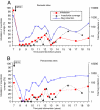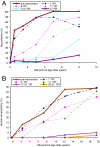Sustainable vector control and management of Chagas disease in the Gran Chaco, Argentina
- PMID: 17913895
- PMCID: PMC2042184
- DOI: 10.1073/pnas.0700863104
Sustainable vector control and management of Chagas disease in the Gran Chaco, Argentina
Abstract
Chagas disease remains a serious obstacle to health and economic development in Latin America, especially for the rural poor. We report the long-term effects of interventions in rural villages in northern Argentina during 1984-2006. Two community-wide campaigns of residual insecticide spraying immediately and strongly reduced domestic infestation and infection with Trypanosoma cruzi in Triatoma infestans bugs and dogs and more gradually reduced the seroprevalence of children <15 years of age. Because no effective surveillance and control actions followed the first campaign in 1985, transmission resurged in 2-3 years. Renewed interventions in 1992 followed by sustained, supervised, community-based vector control largely suppressed the reestablishment of domestic bug colonies and finally led to the interruption of local human T. cruzi transmission. Human incidence of infection was nearly an order of magnitude higher in peripheral rural areas under pulsed, unsupervised, community-based interventions, where human transmission became apparent in 2000. The sustained, supervised, community-based strategy nearly interrupted domestic transmission to dogs but did not eliminate T. infestans despite the absence of pyrethroid-insecticide resistance. T. infestans persisted in part because of the lack of major changes in housing construction and quality. Sustained community participation grew out of establishing a trusted relationship with the affected communities and the local schools. The process included health promotion and community mobilization, motivation, and supervision in close cooperation with locally nominated leaders.
Conflict of interest statement
The authors declare no conflict of interest.
Figures



References
-
- World Health Organization. World Health Report 2004: Changing History. Geneva: WHO; 2004. [Accessed May 30, 2007]. Available at www.who.int/whr/2004/en.
-
- World Health Organization. Control of Chagas Disease. Geneva: WHO; 2002. p. 109. - PubMed
-
- Dias JCP, Silveira AC, Schofield CJ. Mem Inst Oswaldo Cruz. 2002;97:603–612. - PubMed
-
- Feliciangeli MD, Campbell-Lendrum D, Martinez C, Gonzalez D, Coleman P, Davies C. Trends Parasitol. 2003;19:44–49. - PubMed
-
- Silveira AC. In: El control de la enfermedad de Chagas en los países del Cono Sur de América. Historia de una iniciativa internacional. 1991-2001. Silveira AC, Rojas de Arias A, Guillén G, Russomando G, Schenone H, Dias JCP, Valdes Padilla J, Lorca M, Salvatella R, editors. Uberaba, Brazil: Facultad de Medicina do Triangulo Mineiro; 2002. pp. 15–43.
Publication types
MeSH terms
Substances
Grants and funding
LinkOut - more resources
Full Text Sources
Medical

